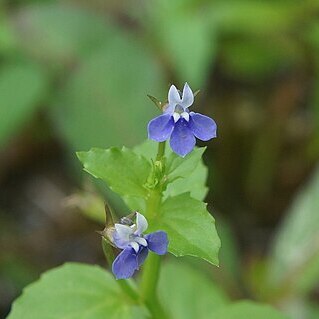Erect to ascending, unbranched to strongly branched herb, 3-35(-40) cm; stem 3-angled and winged. Leaves 0.5-1.5 by 0.5-2 cm, sessile or short-petioled, contracted or narrowed to the base, acute or blunt, entire or toothed, glabrous to sparsely hairy; basal leaves ovate-oblong, cordate or elliptic, upwards sometimes sublan-ceolate, up to 1 by 0.3 cm. Flowers 8-12 mm, axillary, often in the higher axils, and then forming a lax terminal raceme. Pedicels 1-3½ cm, 3-angled, glabrous or slightly patent-hairy. Bracteoles basal, minute to 2 mm long and linear, often caducous. Calyx lobes triangular, subulate, 2.25-3.25 by 0.5-1 mm, entire, sometimes ciliate, glabrous or sparsely hairy. Corolla 4-12 mm, varying from bright blue to violet (sometimes, in Celebes, white), inside hairy (except for the specimens described as L. hosseusii which are glabrous, its var. villosa excluded), with 2 (white) gibbosities, dorsally split to the base, dorsal lobes connate with the lateral ones for 3-4.5 mm, lateral lobes connate with the ventral one for 3.5-6 mm; dorsal lobes 1-3 mm, falcate-oblong or falcate-ovate, acute or acuminate, margin entire or subentire, lateral and ventral lobes oblong or ovate, 1-2.5 mm, acute or acuminate, entire or subentire. Filaments 3-5 mm, free to half-way up or higher, connate, the two anterior ones +-twice as broad as the anthers, the outside patent hairy; dorsal anthers 1.25, ventral ones 1 mm, each anther at the apex with a hair tuft, otherwise glabrous or hairy. Ovary 2-2.5 by 1.5-2.5 mm, oblong, trumpet-shaped to cupular, glabrous or sparsely hairy; style glabrous. Capsule +-hemi-spherical, 2-3 by 1.5-3 mm. Seeds 0.5 by ⅓ mm, trigonous, brown.
More
Herbs, annual, 10-30 cm tall. Stems succulent, decumbent to ascending, laxly branched, glabrous, angular. Leaves alternate, sparse; petiole 1-3 mm, glabrous; blade suborbicular, broadly ovate, elliptic, or lanceolate, 7-14 × 4-6 mm, both surfaces scabrous but glabrous, base cuneate or broadly cuneate, margin crenate or crenulate, apex rounded, obtuse, acute, or acuminate. Flowers axillary at leaflike bracts forming a lax raceme; pedicels (1-)2-2.7 cm, slender, glabrous; base with 2 lanceolate bracteoles ca. 3 mm. Hypanthium funnelform-campanulate, 2-3 mm, glabrous; calyx lobes linear or subulate, slightly longer than tube at anthesis, but shorter than tube in fruit, glabrous, entire. Corolla 2-lipped, pale blue or white, 4-8 mm; upper lobes erect, oblong-oblanceolate; lower lobes spreading, oblong-elliptic. Stamens connate above middle of filaments; filament tube glabrous; anther tube 1-1.5 mm, back glabrous, anthers all barbate at top. Capsule oblong or ovoid, 4-5 × 3-4 mm. Seeds numerous, 3-angular, dark brown. Fl. and fr. Jan-Dec.
A small annual shrub. It grows 3-35 cm high. It is often floating in shallow water. The stem has 3 angles and is winged. The leaves are produced alternately and have almost no leaf stalk. The leaf narrows to the base and can have a sharp tip. The leaves can be toothed around the edge. They are 0.5-1.5 cm long and 0.5-2 cm wide. The flowers have both sexes. They are 8-12 mm long. The flowers are 4-12 mm long and blue. The fruit is a capsule which is half round and 2-3 mm long.
In West Java and in SW. Celebes during the wet season in marshy grassland often dominated by 'siil' (Sorghum nitidum) and/or Cyperaceae; in S. Celebes also along margins of dry rice-fields. In New Guinea this species is found on swampy grounds, together with Erio-caulon, Utricularia, and several Cyperaceae; on wet places in savannahs with Melaleuca, Acacia, Eucalyptus stands and scattered Antidesma ghaesembilla trees. From sea-level up to 1000 m, restricted to regions subject to a dry monsoon. Fl. fr. Nov.-Aug.
More
A tropical plant. It occurs in swampy ground or shallow water. In Papua New Guinea it grows from sea level to 50 m altitude. It grows in paddy fields. In Yunnan.


